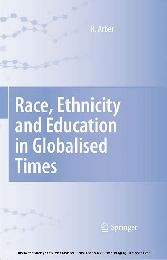
Race, Ethnicity and Education in Globalised Times

von: Ruth Arber
Springer-Verlag, 2008
ISBN: 9781402064586
Sprache: Englisch
219 Seiten, Download: 4365 KB
Format: PDF, auch als Online-Lesen
"Chapter 4 Race and Ethnicity in Globalised Times (p. 61-62)
What sort of Australia will we be in the 21st century?. . . The question can provoke alien-filled nightmares or inspire visions of a culturally diverse and colourblind nation.
Walk down Victoria Street in Richmond, an inner-Melbourne suburb, and the future is an energy-filled maze of supermarkets, restaurants, jewellery stores and neon signs winking exhortations in Chinese and Vietnamese. Feel the force of people building a new life. Most of us do not suffer nightmares, nor are we inspired by visions. Our responses are a mixture of ordinary hopes, vague concerns and puzzling contradictions . . .
It is an astounding story. Since 1946, almost 4.5 million migrants and refugees have settled in Australia. Today, about 40 percent of Australians were either born overseas or have parents who were born overseas. Hidden within our national story are millions of individual sagas of transformation, of people painfully and sometimes joyously remaking themselves. Along the way, the rest of us too have been remade (Gawenda, 1988, p. 8)
In 1988, Gawenda wrote enthusiastically about the creation of ""a culturally diverse and colourblind nation"" and the ""astounding story"" of the settlement of 4.5 million migrants and refugees in a rapidly changing country. It is an understated heroic saga underpinned by hardship and by painful and sometimes joyous change as people each undergo their ""individual sagas of transformation"". This is the story of an ""energy-filled maze of supermarkets"" and ""neon signs winking exhortations in Chinese and Vietnamese"". More than this, it is a story about ""most of us"" who ""do not suffer nightmares"" about the ""rest of us"" who have ""been remade"", and those people who are ""painfully and sometimes joyously remaking themselves"".
Fifteen years later, the way ""we"" in Australia understand ourselves, has changed.
""Politicians and government officials constantly talking about security threats from international terrorism were contributing to a climate of fear in the community and damaging aviation and tourism"", industry leaders warned. . . .""You might increase the risk to the public by actually informing the public and that’s a difficult thing for politicians"", she told The Sunday Age. ""In making these statements, you are actually making it harder to make the system secure and keep people safe. We are in a period of fear. We want information, but when information is provided it actually increases the challenge of making us secure and it increases the costs of making us secure"". (""Curb the talk of terrorism"", The Sunday Age, 17 August 2003, p. 1).
Fifteen years after Gawenda’s article was written, ""we"" are in ""a period of fear"", a time of ""threat"", a place where ""you might increase the risk"", one from which we must ""make the system secure and keep people safe"". The source of our trepidation is the ""international terrorist"" and yet we know very little about him or her. To even name such a person is dangerous."







